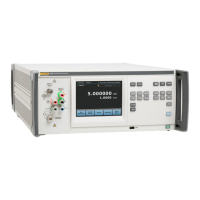Calibration Adjustment and Verification
Calibration 3
3-29
Characterizing the AC Source
To meet the test uncertainty requirements for WIDEBAND input calibration, you
must first characterize the ac source and its dedicated Wideband cable to be
used in the procedure. You must characterize the source and calibrate the
WIDEBAND input in a temperature-controlled room. The EL1100 Thermal
Converter will not stabilize in a drafty or unstable environment. In this procedure,
you will fill in the 5730A ERROR column of Table 3-8 for later use during the
WIDEBAND flatness calibration.
Note
Fluke Calibration offers a calibration service for Precision
Measurement EL1100 and JFW attenuators at the Fluke Primary
Laboratory. For price and delivery of this calibration service, please
see How to Contact Fluke Calibration.
1. Connect the equipment as shown in Figure 3-10.
Fluke 5730A
WIDEBAND
OUTPUT
Keithley 2182A
3 Volt
Thermal Converter
Model EL1100
elu035.eps
Figure 3-11. Wideband Calibration Source Characterization, Part 1
2. Make sure equipment warmup requirements are met.
3. Set the 5730A to output 3.2 V at 1 kHz. The TVC output will be about
7 mV.
4. Allow the TVC to stabilize (warm up for at least 10 minutes), then push
the STORE and ENTER keys on the DMM to average 20 readings for
statistics. Push REL on the DMM to zero the display. This measurement
will be used as a baseline for drift detection as well as signal leveling at
each test frequency.
5. For each frequency in Table 3-8, set the 5730A frequency and perform
steps 6 and 7.
6. Apply any corrections for the response of the TVC by first adjusting the
5730A output to bring the DMM offset reading to 0 ±1 µV, and then
pushing the NEW REF key on the 5730A, and then further adjusting the
5730A to give the same error and sign as recorded on the EL1100
calibration sheet when it was calibrated. Also record the TVC correction in
Table 3-8.
7. Return to 3.2 V at 1 kHz after each frequency calibrated to verify that the
meter is still reading 0. Rezero the DMM if necessary by pushing the REL
key again.
8. Set the 5730A to STANDBY.
9. The characterization of the source for absolute measurements
establishes the actual output of the calibrator at 1 kHz when the calibrator

